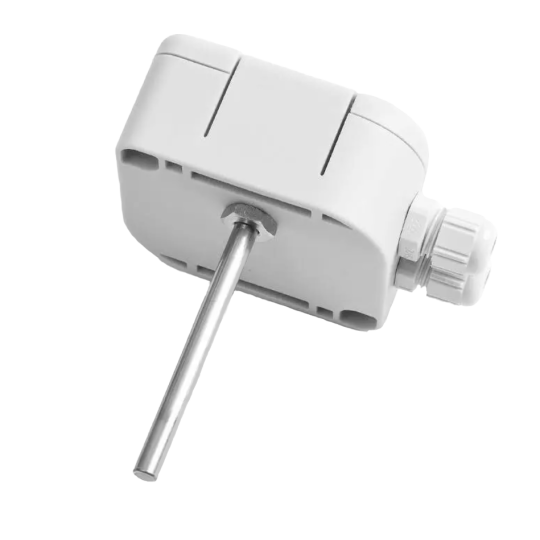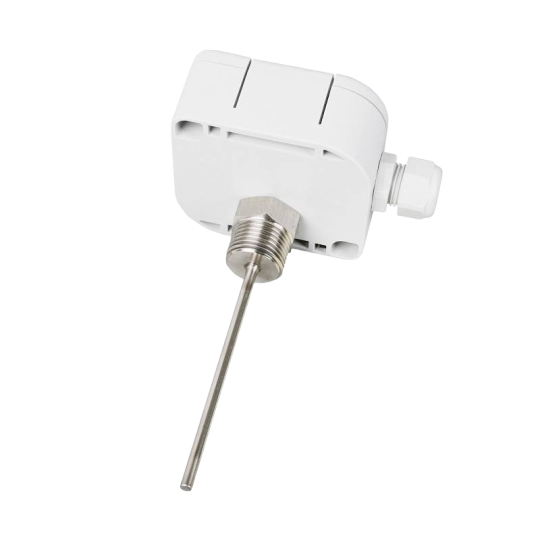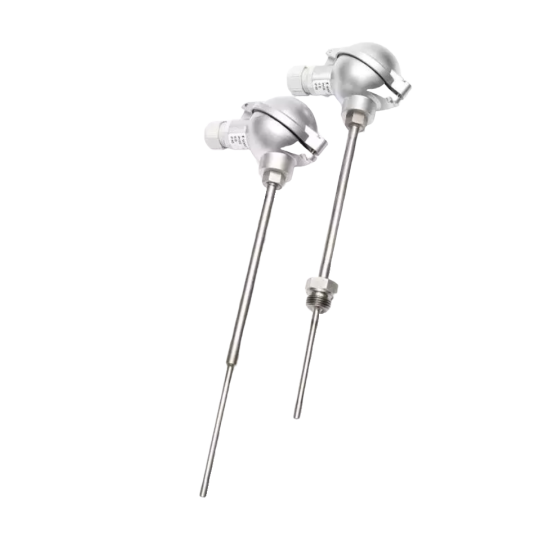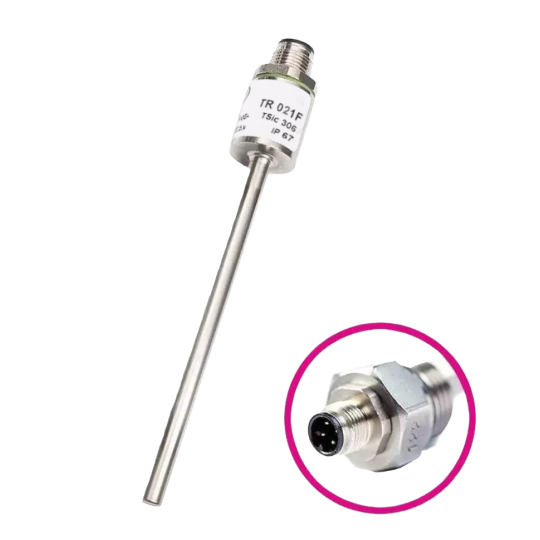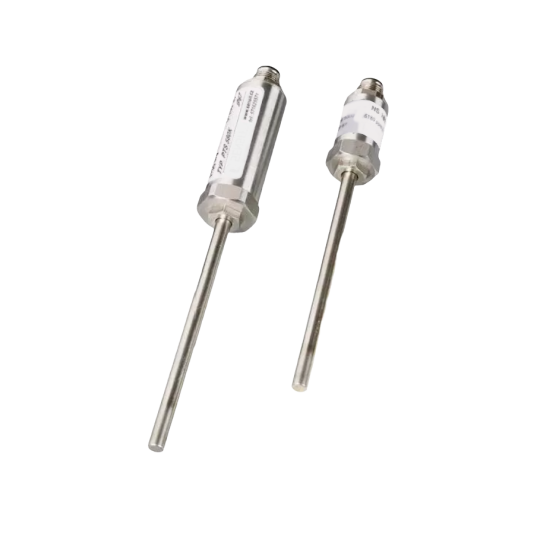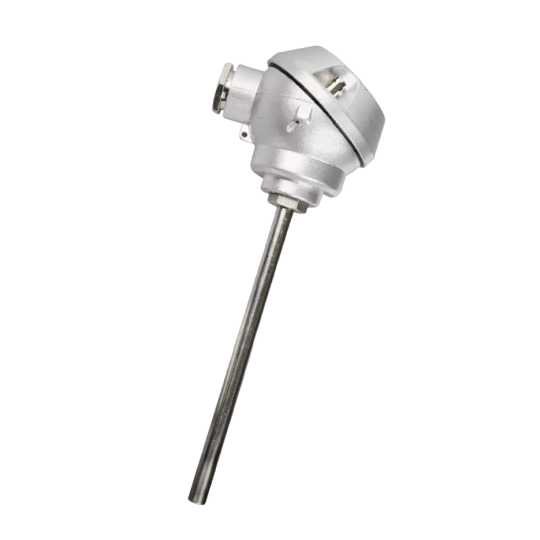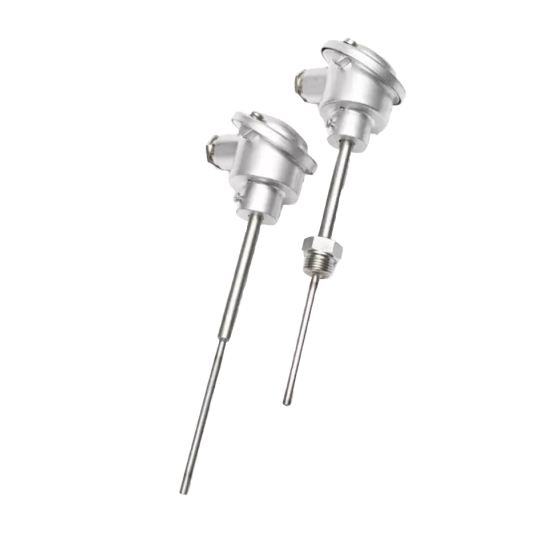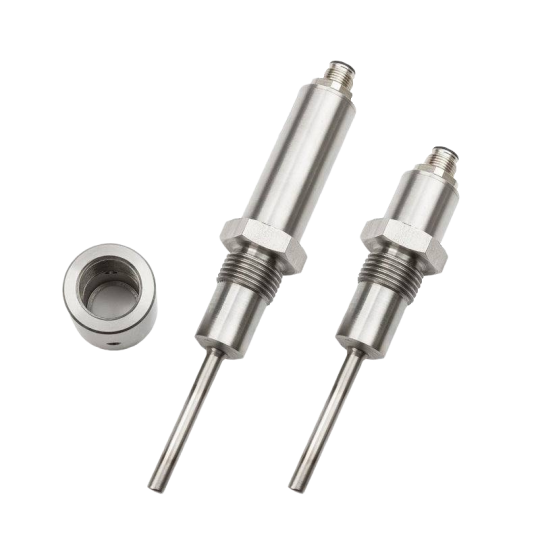
Temperature probe with stainless steel head and plunger for the food industry
- 5,94 mm diameter
- -50 to 200 ° C
- Sensor of your choice
- IP 67
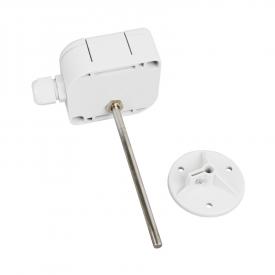
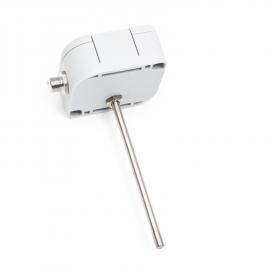
DESCRIPTION AND APPLICATION
These resistance temperature sensors are designed to measure the contact temperature of liquid or gaseous substances. The plastic connection head is provided with a cable outlet (the terminal block is placed in the connection head) or a connector.
La combination temperature sensor and central supportIt is suitable for temperature measurements in air conditioning ducts. The combination temperature sensor and thermowells suitable for temperature measurements in tubes.
The temperature sensor variant with welded thread is ideal for the direct measurement of fluids in pipes. The standard operating temperature range is between -30°C and 150°C.
By using a sensor with a longer rod, the upper limit of allowable temperature can be extended up to 250°C. Temperature sensors can be used for any compatible control system with the sensing element output signals or the output signals shown in the sensing element type table.
The temperature sensor is easy to mount thanks to the unique design "S-head".
ACCESSORIES
DECLARATION, CERTIFICATION, CALIBRATION
| Sensor type (K - with connector) |
NS 120 NS 120K |
NS 121 NS-121K |
NS 122 NS-122K |
NS 320 NS-320K |
NS 321 NS-321K |
| Sensitive element type | Nor 1000/5000 | Nor 1000/6180 | Ni 891 | Nor 10000/5000 | Nor 10000/6180 |
| Measuring range | -30 to 150 ° C | ||||
| Maximum continuous current | 1 mA | 1 mA | 1 mA | 0.3 mA | 0.3 mA |
| Sensor type (K - with connector) |
NS 123 NS-123K |
PTS 120 PTS 120K |
PTS 220 PTS 220K |
PTS 320 PTS 320K |
HS 120 HS 120K |
| Sensitive element type | T1 = Ni 2226 | Point 100/3850 | Point 500/3850 | Point 1000/3850 | 20 kΩ NTC thermistor |
| Measuring range | -30 to 150 ° C | - 50 to 150 ° C (ambient temperature of the connection head -30 to 100 ° C) | -30 to 150 ° C | ||
| Maximum continuous current | 0.7 mA | 3 mA | 1.5 mA | 1 mA | 10 mW *) |
*) maximum power consumption
| Sensor type (K - with connector) |
NS 520 NS-520K |
NS 720 NS-720K |
Footnotes |
| Sensitive element type | Point 1000/3850 | Pt 1000/3850 |
|
| Output signal | 4 to 20 mA | 0 to 10 V | |
| Measuring ranges | -50 to 50 ° C -30 to 60 ° C 0 to 35 ° C 0 to 100 ° C 0 to 150 ° C 0 to 200 ° C 0 to 250 ° C |
-30 to 60 ° C 0 to 35 ° C 0 to 100 ° C 0 to 150 ° C 0 to 200 ° C 0 to 250 ° C |
ambient temperature around the connection head -30 to 70 ° C |
| Power supply (U) | 11 to 30 V DC | 15 to 30 V DC | recommended value 24 V DC |
| Load resistance | 150 Ω for 12 VDC power supply 700 for 24 VDC supply |
> 10 kΩ | |
| Output signal breaking the sensitive element |
> 24 mA | > 10,5 V | |
| Output signal - short circuit of the detection element |
<3.5 mA | ~0V |
**) Depending on customer requirements, it is possible to provide a custom measurement range from -40 to 150 ° C; the minimum range of the range must be 35 ° C (for example, -20 to 15 ° C; -30 to 80 ° C)
| OTHER PARAMETERS | |
| Precision class | Elements sensitive to Ni: class B, Δt = ± (0,4 + 0,007t), for t ≥ 0; Δt = ± (0,4 + 0,028 | t |), for t ≤ 0 in ° C; Elements sensitive to pt: class B according to EN 60751, Δt = ± (0,3 + 0,005 | t |) in ° C NTC 20 kΩ: ± 1 ° C for the range from 0 to 70 ° C |
| Measurement error for NS 520 (K), NS 720 (K) | <0,6% of the measuring range, minimum 0,5 ° C NS 840 (K) 0,5 ° C for a range with a range <100 ° C, <0,6% of the range with a range> 100 ° C |
| Sensor connection | according to the wiring diagram |
| Standard length of rod L1 | 70, 120, 180, 240, 300, 360, 420 mm |
| Response time | τ 0,5 <9 s (in white water at 0,4 ms -1 ) |
| Recommended wire section - sensors with washer |
0,35 to 1,5 mm 2 |
| Connector type in sensors head with connector |
RSFM4 - Lumberg |
| Isolation resistance | > 200 MΩ at 500 V DC, 25 ° ± 3 ° C; humidity <85% |
| Ingress protection | IP 65 mismatch with EN 60529 |
| Sensor rod material | DIN 1.4301 stainless steel |
| Connection head material | POLYAMIDE |
| operating conditions | ambient temperature: -30 to 100 ° C; -30 to 80 ° C with a converter; -30 to 70 ° C with frequency output relative humidity: max. 100% (at room temperature 25 ° C) atmospheric pressure: 70 to 107 kPa |
| Weight | about 0,15 kg |
SENSOR INSTALLATION AND MAINTENANCE
WELL DETECTORS:
Before connecting the power cable, pry off the plastic connection head cover using a flat screwdriver. The input cable is connected to the terminals according to the wiring diagram through the loose eyelet. The recommended wire section is 0,35 to 1,5 mm2.
The diameter of the circular section cable can range from 4 to 8 mm. To ensure the protection value IP 65 , the grommet must be tight and the cover must be put on after connecting the input cable.
SENSORS WITH CONNECTOR:
The input cable with connector is connected to the RSFM4 connector, which is part of the sensor head. Optionally the autonomous CONEC connector 43-00092, or an input cable with a length of 5 m equipped with a straight RKT connector, or a rectangular type RKWT connector can be delivered.
To guarantee the protection value IP 65, the connectors and the sensor cover must be tightened and checked. If the input cable is laid near high voltage conductors or those supplying equipment creating a disturbing electromagnetic field (eg equipment with an inductive load), shielded cable must be used.
When using a stainless steel thermowell or stainless steel bracketthese
accessories should be placed first where the temperature will be measured. Then the sensor is inserted into the holder or pushed as far down the thermowell, and tightened with a screw.
Openings for the installation of the plastic clamp must be drilled in accordance with the dimensions sketch on which the opening diameters and the distances from their centers are illustrated.
After installing and connecting the sensor to the equipment, the sensor is ready for use. The sensor does not require any special servicing or maintenance. The device can be used in any working position, but the eyelet must not be pointing upwards.
MODIFICATION AND CUSTOMIZATION
FOR MANUFACTURED STANDARD DETECTORS, THE FOLLOWING PARAMETERS CAN BE CHANGED:

